Angioplasty: Fixing Blockages in the Heart
Mahmoud Sharaf MD, FRCPC
Interventional Cardiologist
Eau Claire Heart Institute
Eau Claire
Cardiovascular disease affects nearly 80 million Americans. It is the leading cause of death in the United States. Each year, there are over 1.5 million heart attacks. The need to prevent these cardiovascular events, and to treat them when they occur, is a major focus of public health. Angioplasty is a highly-specialized procedure used by interventional cardiologists to open up blockages in the heart’s arteries. Angioplasty reduces symptoms related to cardiovascular disease, improves quality of life and prevents death.
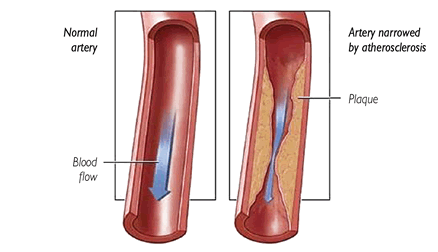
Smoking, high-fat diets, inactivity and diabetes are risk factors that lead to cholesterol deposits within arteries, a process known as atherosclerosis. These deposits (plaques) grow and can narrow an artery to a critical point. The first warning signs of this narrowing are chest pain (angina), shortness of breath, fatigue, lightheadedness and palpitations.
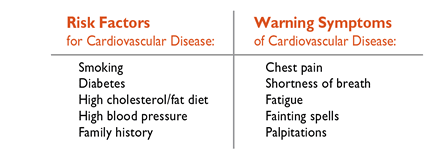
Patients with these symptoms should see their doctor promptly. In addition to healthy diet, lifestyle changes, and medications, many patients benefit from angioplasty to address the underlying artery narrowing.
Angioplasty first begins by acquiring pictures of the heart’s arteries. Access is typically made by a needle in the artery of the groin. A sheath is inserted into the artery of the groin to assure continuous access to the bloodstream. Afterwards, a plastic tube is manipulated from outside of the body, where the cardiologist stands, all the way up into the heart. A special dye is injected through the plastic tube while X-ray beams are projected, and this identifies any areas of narrowing or blockage within the heart.
When a narrowing or blockage is found, angioplasty begins. This is accomplished by inserting a thin metal wire (1/100th inch thick) through the guiding catheter, into the artery. The metal wire is the platform to deliver balloons and stents to the area of narrowing or blockage. The balloon is inflated and this displaces plaque and opens up the artery. After the initial ballooning, a stent is placed across the narrowing and deployed. The stent provides firm support, and gives a more durable result than ballooning alone.
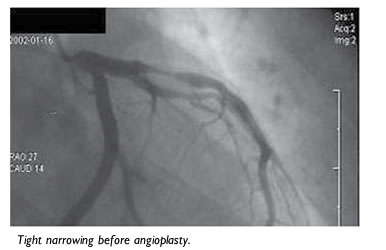
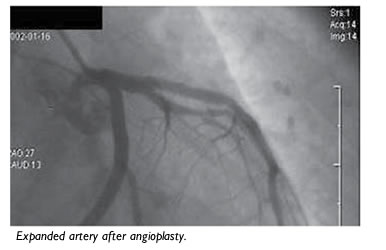
Angioplasty is also performed in the context of an acute heart attack. A heart attack typically presents as sustained chest pain or shortness of breath for over 20 minutes, or as a sudden loss of consciousness or dramatic fall in blood pressure. These symptoms require immediate medical attention. Angioplasty, when performed early, saves lives by directly restoring blood flow in the heart and minimizing damage to heart muscle.
Angioplasty can also be performed through the radial artery (in the wrist) in most patients. The equipment used is similar to that used in the traditional femoral artery (groin) approach. However, the longer, more complex path from the wrist to the heart requires that the interventional cardiologist be highly experienced in this approach. The effectiveness of balloons and stents is identical between radial and femoral approaches, but the radial approach is associated with shorter recovery times, less pain and less bleeding than the femoral approach.
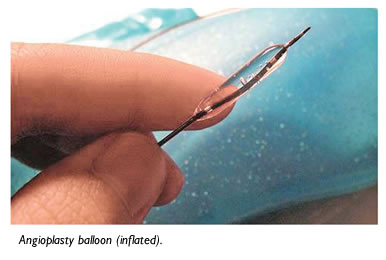
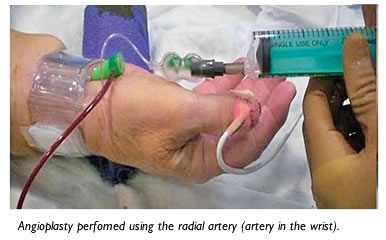
After angioplasty is performed, ongoing medication treatment is crucial. Aspirin and clopidogrel (plavix) are vital to prevent blood clots from forming within the stent during the critical weeks after angioplasty, when the artery is still healing. Reduction in cholesterol and blood pressure, quitting smoking, and excellent control of diabetes are important to ensure that narrowing does not re-develop within the artery.
The management of cardiovascular disease is a crucial part of maintaining good personal and public health. It begins with prevention, and addressing health risks like smoking, high blood pressure, high cholesterol and physical inactivity. In the appropriate individuals, angioplasty directly reverses critical narrowing in the heart and reduces symptoms, improves quality of life, and saves lives.
Mahmoud Sharaf, MD, FRCPC –
Eau Claire Heart Institute
For information or to schedule an appointment:
715.831.4444
Dr. Sharaf sees patients in Eau Claire.





 © 2009 OakLeaf Medical Network and OakLeaf Surgical Hospital. All rights reserved.
© 2009 OakLeaf Medical Network and OakLeaf Surgical Hospital. All rights reserved.